
Matteuccia is a genus of ferns with one species: Matteuccia struthiopteris. The species epithet struthiopteris comes from Ancient Greek words στρουθίων (strouthíōn) "ostrich" and πτερίς (pterís) "fern".

Blitum bonus-henricus, also called Good-King-Henry, poor-man's asparagus, perennial goosefoot, Lincolnshire spinach, Markery, English mercury, or mercury goosefoot, is a species of goosefoot which is native to much of central and southern Europe.

Lapsana communis, the common nipplewort, is a species of flowering plant in the sunflower family. It is native to Europe and southwestern Asia. and widely naturalized in other regions including North America.

Aconitum lycoctonum is a species of flowering plant in the genus Aconitum, of the family Ranunculaceae, native to much of Europe and northern Asia.
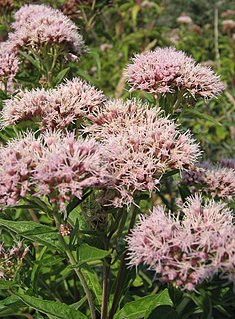
Eupatorium cannabinum, commonly known as hemp-agrimony, or holy rope, is a herbaceous plant of the daisy family. It is a robust perennial native to many areas of Europe. It is cultivated as an ornamental and occasionally found as a garden escape in scattered locations in China, the United States and Canada. It is extremely attractive to butterflies, much like buddleia.
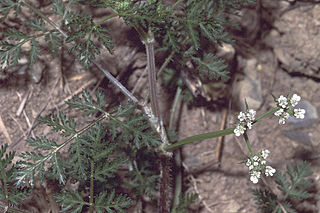
Caucalis platycarpos is a species of flowering plant in the family Apiaceae, the only member of the genus Caucalis. Common names are carrot bur parsley, small bur-parsley, and burr parsley. It is native to Europe, North Africa, and the Middle East as far east as Iran.
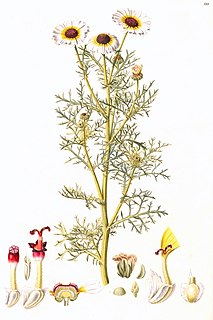
Ismelia carinata, the tricolour chrysanthemum, tricolor daisy, or annual chrysanthemum, is an ornamental plant native to north Africa that is cultivated as a garden plant and grows as a weed in California. It is the sole species in the genus Ismelia. It has been hybridized with related Argyranthemum species to create cultivars of garden marguerites.
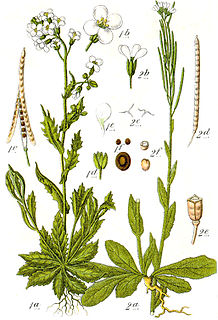
Arabis hirsuta, known as hairy rock-cress, is a flowering plant of the genus Arabis in the family Brassicaceae. In previous North American works, this species has been broadly defined to include plants native to Europe, Asia, and the northern half of North America, but is now more often restricted to a narrower subgroup restricted to Europe.

Cicerbita alpina, commonly known as the alpine sow-thistle or alpine blue-sow-thistle is a perennial herbaceous species of plant sometimes placed in the genus Cicerbita of the family Asteraceae, and sometimes placed in the genus Lactuca as Lactuca alpina. It is native to upland and mountainous parts of Europe.

Galium saxatile or heath bedstraw is a plant species of the genus Galium. It is related to cleavers.

Verbena urticifolia, known as nettle-leaved vervain or white vervain, is a herbaceous plant in the vervain family (Verbenaceae). It belongs to the "true" vervains of genus Verbena.

Cyclospermum leptophyllum is a species of plant in the family Apiaceae known by the common names marsh parsley, slender celery and fir-leaved celery. This is a plant found worldwide at warm temperate to tropical latitudes and is considered a noxious weed in many areas. It is a taprooted branching herb reaching just over half a meter in height at maximum. It has threadlike green leaves a few centimeters long and small umbels of spherical flowers.

Glyceria maxima, commonly known as great manna grass, reed mannagrass, reed sweet-grass, and greater sweet-grass is a species of rhizomatous perennial grasses in the mannagrass genus native to Europe and Western Siberia and growing in wet areas such as riverbanks and ponds. It is highly competitive and invasive and is often considered to be a noxious weed outside its native range.
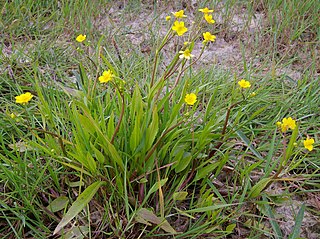
Ranunculus flammula, the lesser spearwort, greater creeping spearwort or banewort, is a species of perennial herbaceous plants in the genus Ranunculus (buttercup), growing in damp places throughout the Boreal Kingdom. It flowers June/July. Ranunculus flammula is poisonous. It is very closely related to R. reptans, which is distinguished by prostrate and more slender stems, narrower leaves and smaller flowers and is sometimes included within R. flammula sensu lato as a variety.
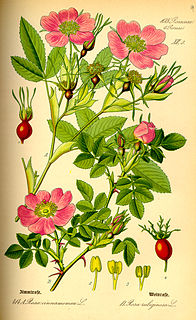
Rosa majalis is a species of deciduous shrubs in the genus Rosa, native to forests of Europe and Siberia. It grows to 2 m. and yields edible hip fruits rich in vitamin C, which are used in medicine and to produce rose hip syrup.

Geropogon is a genus of flowering plants in the dandelion family.
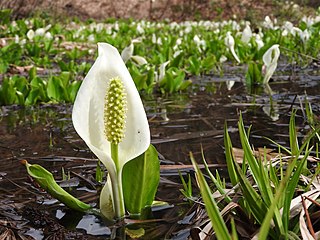
Lysichiton camtschatcensis, common name Asian skunk-cabbage or white skunk cabbage, is a plant found in swamps and wet woods, along streams and in other wet areas of the Kamchatka Peninsula, the Kuril Islands, Sakhalin and northern Japan. The common name "skunk cabbage" is used for the genus Lysichiton, which includes L. americanus, the western skunk cabbage, noted for its unpleasant smell. The Asian skunk cabbage is more variable: plants have been reported in different cases to smell disgusting, not at all, and sweet. In Japanese it is known as mizubashō from a supposed similarity to the Japanese banana, a name with poetic rather than malodorous associations. It is not closely related to the true cabbage.

Symphyotrichum dumosum is a species of flowering plant in the aster family. It is native to a widespread area across the eastern half of the United States from Texas to Florida to Maine to Wisconsin. It is also native to Ontario, introduced in New Brunswick, and cultivated in other places. It is commonly known as rice button aster and bushy aster.
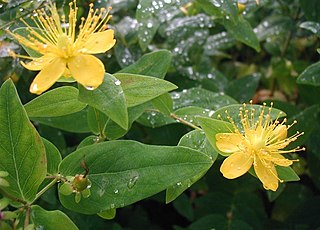
Hypericum hircinum, also known as stinking tutsan, is a shrubby flowering plant in the St. John's wort family Hypericaceae.



















